Anyone using/tried the E28-2G4M27S 2.4Ghz LoRa SX1280 27dB module?
-
@mfalkvidd How about this then?
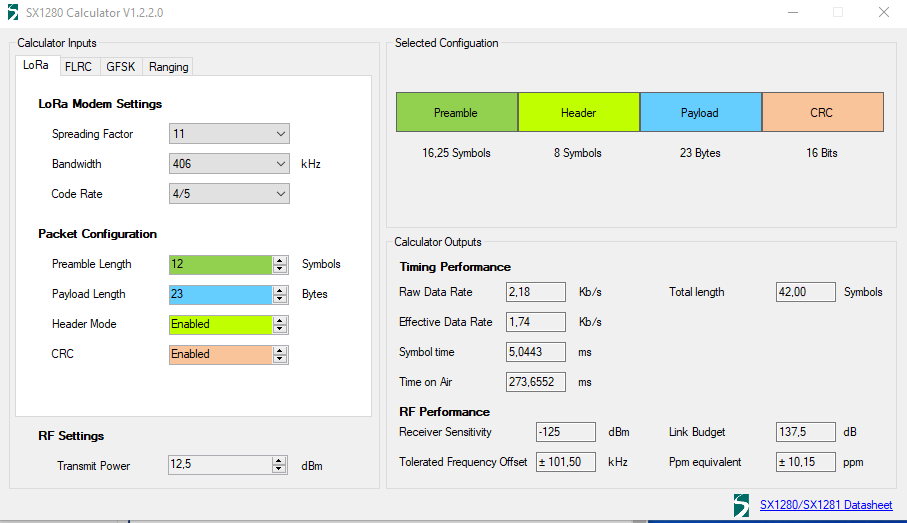
I'm spitballing this. If anyone has a better idea, or a correction, please do post!
-
I found an IPEX to SMA adapter, and so I changed the antenna selector to select the soldered on IPEX connector and then borrowed an antenna from an unused wifi base station and connected it to the Ebyte module, like so, just to see if it would work at all.
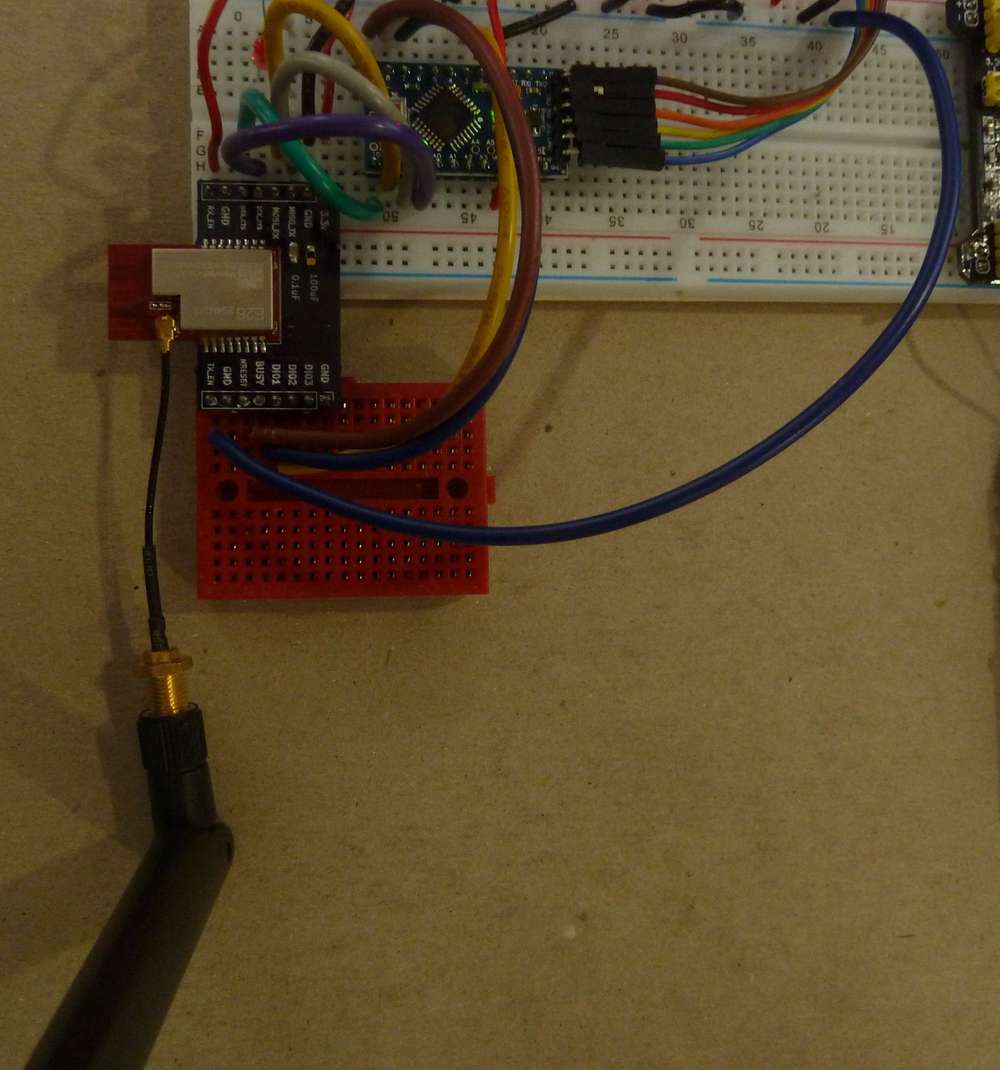
Doing this yielded a big improvement in Link Budget. Doing the same type of conversion on the LoRa transmitter module should make a noticeable difference, though I'm doubtful as to whether it will make enough of an improvement that it will perform as well as my AI-Thinker LoRa modules. Nonetheless, I'll attempt another, different, antenna hookup tomorrow when more antenna parts arrive from Amazon, and after testing it, I'll endeavor to reach a final conclusion.
Chasing down all these loose ends has been tedious, so if anyone finds this blog useful, please leave a thumbs-up to this posting. so that I know I'm not wasting my time writing it all down. At the moment I'm liking my AI-Thinker LoRa modules better: they have much better range and without all this fanfare they seem to "just work" straight out of the box.
-
It turns out Ebyte is kind enough to recommend specific antennas to use with this LoRa module:

Unfortunately, these recommended antenna antenna models do not appear to be stocked by either Amazon or Mouser. Instead, it appears you may have to order them fromAliexpress:
https://www.ebyte.com/en/product-class.html?key=tx2400 So, your best bet would be to order the Ebyte antennas at the same time you order your Ebyte LoRa modules. Unfortunately, I didn't, and I'm now getting the distinct impression that ordering suitable antennas from Amazon is a crapshoot, because I've found supposedly different dipole antennas, but with the exact same dimensions, being marketed for both the 915Mhz band and for the 2.4Ghz band. Surely that can't be right?! :face_with_rolling_eyes: -
This is, allegedly, one of the TX2400-JW-5 antenna's that Ebyte recommends:
https://www.aliexpress.com/item/1005003096039403.html?spm=a2g0o.cart.0.0.63133c00YzHVcW&mp=1and this, it looks to me, is probably the same antenna, available on amazon:
https://www.amazon.com/gp/product/B093BVNPBW/ref=ppx_yo_dt_b_asin_title_o04_s00?ie=UTF8&th=1and which I'll be testing whenever it finally arrives from amazon (sometime soon). That way I'll be testing within manufacturer guidelines.
-
Reporting back: I first tried a dipole antenna bought on amazon (link above) that was allegedly for 2.4ghz:
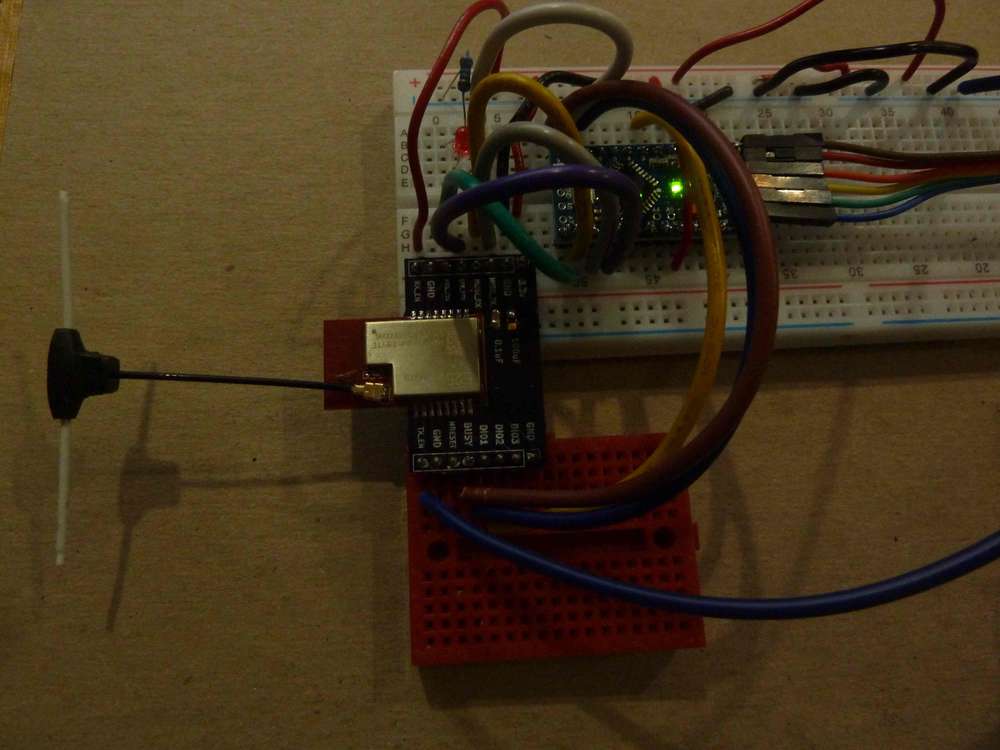
I put this on both the transmitter and the receiver. The good news is that the IPEX connector made a very snug fit with the EBYTE module, but the bad news is that the results were terrible:5s Hello World 1234567890*,CRC,DAAB,RSSI,-81dBm,SNR,-2dB,Length,23,Packets,1,Errors,0,IRQreg,8012 8s Hello World 1234567890*,CRC,DAAB,RSSI,-87dBm,SNR,-18dB,Length,23,Packets,2,Errors,0,IRQreg,8012 10s PacketError,RSSI,-78dBm,SNR,-20dB,Length,23,Packets,2,Errors,1,IRQreg,8052,IRQ_RX_DONE,IRQ_HEADER_VALID,IRQ_CRC_ERROR,IRQ_PREAMBLE_DETECTED 13s PacketError,RSSI,-78dBm,SNR,-14dB,Length,23,Packets,2,Errors,2,IRQreg,8052,IRQ_RX_DONE,IRQ_HEADER_VALID,IRQ_CRC_ERROR,IRQ_PREAMBLE_DETECTED 15s Hello World 1234567890*,CRC,DAAB,RSSI,-87dBm,SNR,-16dB,Length,23,Packets,3,Errors,2,IRQreg,8012 18s PacketError,RSSI,-80dBm,SNR,-7dB,Length,23,Packets,3,Errors,3,IRQreg,8052,IRQ_RX_DONE,IRQ_HEADER_VALID,IRQ_CRC_ERROR,IRQ_PREAMBLE_DETECTED 32s PacketError,RSSI,-80dBm,SNR,-14dB,Length,23,Packets,3,Errors,4,IRQreg,8052,IRQ_RX_DONE,IRQ_HEADER_VALID,IRQ_CRC_ERROR,IRQ_PREAMBLE_DETECTED 40s PacketError,RSSI,-85dBm,SNR,-21dB,Length,23,Packets,3,Errors,5,IRQreg,8052,IRQ_RX_DONE,IRQ_HEADER_VALID,IRQ_CRC_ERROR,IRQ_PREAMBLE_DETECTED 41s PacketError,RSSI,-86dBm,SNR,-17dB,Length,23,Packets,3,Errors,6,IRQreg,8052,IRQ_RX_DONE,IRQ_HEADER_VALID,IRQ_CRC_ERROR,IRQ_PREAMBLE_DETECTED 101s RXTimeout 106s PacketError,RSSI,-72dBm,SNR,-12dB,Length,23,Packets,3,Errors,7,IRQreg,8052,IRQ_RX_DONE,IRQ_HEADER_VALID,IRQ_CRC_ERROR,IRQ_PREAMBLE_DETECTED 114s PacketError,RSSI,-75dBm,SNR,-11dB,Length,23,Packets,3,Errors,8,IRQreg,8052,IRQ_RX_DONE,IRQ_HEADER_VALID,IRQ_CRC_ERROR,IRQ_PREAMBLE_DETECTED 116s PacketError,RSSI,-76dBm,SNR,-11dB,Length,23,Packets,3,Errors,9,IRQreg,8052,IRQ_RX_DONE,IRQ_HEADER_VALID,IRQ_CRC_ERROR,IRQ_PREAMBLE_DETECTEDSo, time to finally try the factory recommended antenna (also linked above). Unfortunately, the IPEX to SMA adapter I got was the wrong kind (female SMA instead of male SMA), so I had to fall back onto the only one Ipex-to-male-sma adapter I had. So, I put that on the receiver and left the transmitter with the dubious dipole antenna:
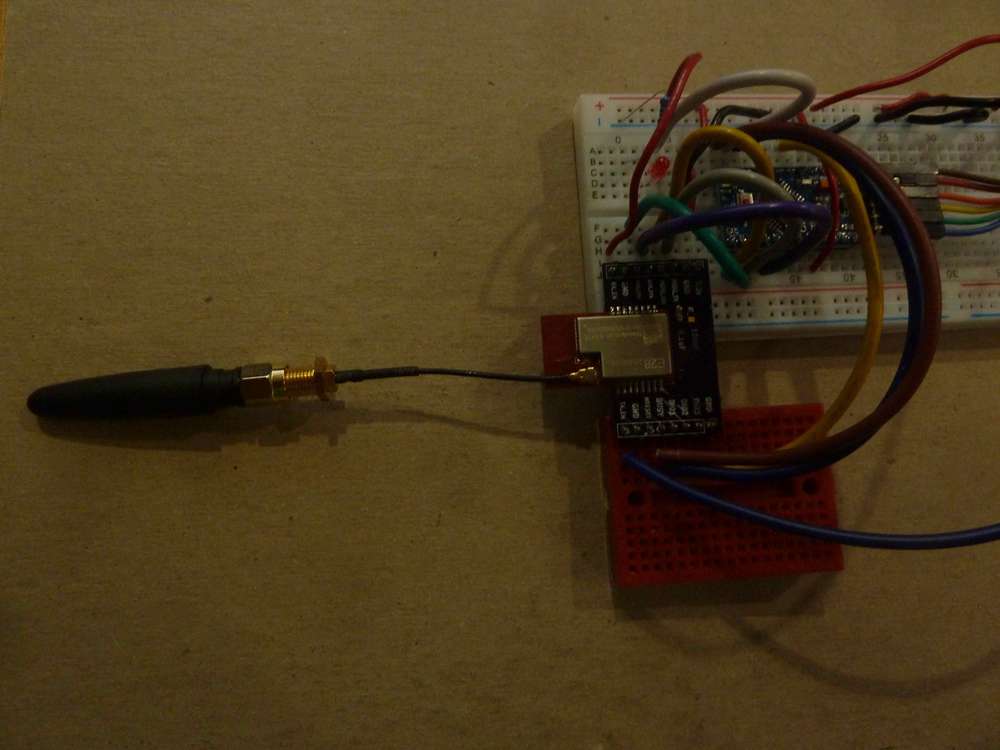
More bad news was that the IPEX connector on this adapter made a rather loosey-goosey connection to the Ebyte module. How can that be? Are there different sizes/types of IPEX connectors or something? But, I went with it anyway because it's all I have at the moment, and the good news is that the result was tangible improvement:4s Hello World 1234567890*,CRC,DAAB,RSSI,-67dBm,SNR,-3dB,Length,23,Packets,1,Errors,0,IRQreg,8012 6s PacketError,RSSI,-67dBm,SNR,-2dB,Length,23,Packets,1,Errors,1,IRQreg,8052,IRQ_RX_DONE,IRQ_HEADER_VALID,IRQ_CRC_ERROR,IRQ_PREAMBLE_DETECTED 7s Hello World 1234567890*,CRC,DAAB,RSSI,-72dBm,SNR,-11dB,Length,23,Packets,2,Errors,1,IRQreg,8012 9s Hello World 1234567890*,CRC,DAAB,RSSI,-66dBm,SNR,-3dB,Length,23,Packets,3,Errors,1,IRQreg,8012 10s Hello World 1234567890*,CRC,DAAB,RSSI,-67dBm,SNR,-2dB,Length,23,Packets,4,Errors,1,IRQreg,8012 11s Hello World 1234567890*,CRC,DAAB,RSSI,-71dBm,SNR,-7dB,Length,23,Packets,5,Errors,1,IRQreg,8012 13s Hello World 1234567890*,CRC,DAAB,RSSI,-66dBm,SNR,2dB,Length,23,Packets,6,Errors,1,IRQreg,8012 15s PacketError,RSSI,-68dBm,SNR,-6dB,Length,23,Packets,6,Errors,2,IRQreg,8052,IRQ_RX_DONE,IRQ_HEADER_VALID,IRQ_CRC_ERROR,IRQ_PREAMBLE_DETECTED 18s Hello World 1234567890*,CRC,DAAB,RSSI,-66dBm,SNR,-5dB,Length,23,Packets,7,Errors,2,IRQreg,8012 19s PacketError,RSSI,-71dBm,SNR,-14dB,Length,23,Packets,7,Errors,3,IRQreg,8052,IRQ_RX_DONE,IRQ_HEADER_VALID,IRQ_CRC_ERROR,IRQ_PREAMBLE_DETECTED 20s Hello World 1234567890*,CRC,DAAB,RSSI,-64dBm,SNR,0dB,Length,23,Packets,8,Errors,3,IRQreg,8012 23s Hello World 1234567890*,CRC,DAAB,RSSI,-65dBm,SNR,0dB,Length,23,Packets,9,Errors,3,IRQreg,8012 25s Hello World 1234567890*,CRC,DAAB,RSSI,-66dBm,SNR,1dB,Length,23,Packets,10,Errors,3,IRQreg,8012 28s Hello World 1234567890*,CRC,DAAB,RSSI,-65dBm,SNR,-3dB,Length,23,Packets,11,Errors,3,IRQreg,8012 29s Hello World 1234567890*,CRC,DAAB,RSSI,-73dBm,SNR,-10dB,Length,23,Packets,12,Errors,3,IRQreg,8012 30s Hello World 1234567890*,CRC,DAAB,RSSI,-71dBm,SNR,-10dB,Length,23,Packets,13,Errors,3,IRQreg,8012 32s PacketError,RSSI,-66dBm,SNR,-15dB,Length,23,Packets,13,Errors,4,IRQreg,8052,IRQ_RX_DONE,IRQ_HEADER_VALID,IRQ_CRC_ERROR,IRQ_PREAMBLE_DETECTED 33s Hello World 1234567890*,CRC,DAAB,RSSI,-71dBm,SNR,-9dB,Length,23,Packets,14,Errors,4,IRQreg,8012 34s Hello World 1234567890*,CRC,DAAB,RSSI,-75dBm,SNR,-12dB,Length,23,Packets,15,Errors,4,IRQreg,8012 36s Hello World 1234567890*,CRC,DAAB,RSSI,-74dBm,SNR,-10dB,Length,23,Packets,16,Errors,4,IRQreg,8012 37s Hello World 1234567890*,CRC,DAAB,RSSI,-67dBm,SNR,-1dB,Length,23,Packets,17,Errors,4,IRQreg,8012 38s PacketError,RSSI,-72dBm,SNR,-20dB,Length,23,Packets,17,Errors,5,IRQreg,8052,IRQ_RX_DONE,IRQ_HEADER_VALID,IRQ_CRC_ERROR,IRQ_PREAMBLE_DETECTED 39s PacketError,RSSI,-68dBm,SNR,-5dB,Length,23,Packets,17,Errors,6,IRQreg,8052,IRQ_RX_DONE,IRQ_HEADER_VALID,IRQ_CRC_ERROR,IRQ_PREAMBLE_DETECTED 42s Hello World 1234567890*,CRC,DAAB,RSSI,-71dBm,SNR,-7dB,Length,23,Packets,18,Errors,6,IRQreg,8012What's immediately evident is a big improvement in both the RSSI and the SNR. Bear in mind that this improvement is with the factory recommended antenna on only the receiver module. The seemingly lousy dipole antenna is still on the transmitter module.
So.... next step is to order the right kind of IPEX to male SMA connector and see how it fares when the factory recommended antenna is connected to both the transmitter module and the receiver modules.
-
A related topic is: just what kind of component is the antenna selector anyway?
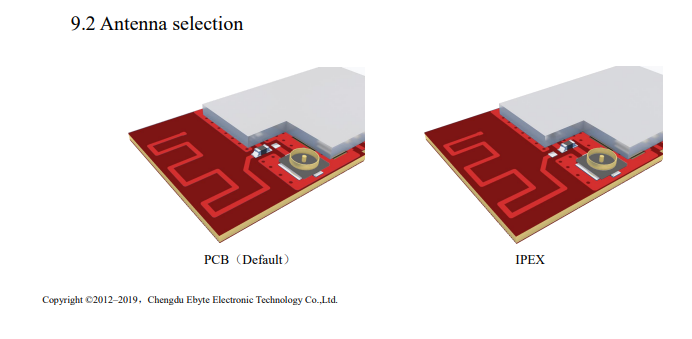
My measurements suggest it is just a zero ohm resistor. It's very tiny, however, which makes it difficult to desolder and then re-solder to the right pads when changing the selection. I did do that on the receiver module, but on the transmitter module I removed the selector component and then used a solder bridge to enable the IPEX antenna connector and disable the trace antenna. -
Reporting back: Answering my own question about the retention force on u.fl connectors, it turns out you may get only 5 connects/disconnects before the connector is shot and needs replacing. Source:
https://www.youtube.com/watch?v=naJvFB52EtcSo, I'm guessing that why the u.fl connector on only my u.fl to sma adapter cable became loosey-goosey, as I described above. Fortunately, at least according to this source, the u.fl connector on the PCB doesn't wear out. It's just the cable connector side that does.
-
Yes, the antenna selector is normally just a zero ohm resistor.
About the antenna sma connector: there are 4 connectors, not 2.

@mfalkvidd Thanks for that! So, it appears that what I need are the RP-SMA connectors, not the SMA connectors. All the wifi stuff is generally RP-SMA for instance. Yet another picture (duplicative of yours) to drive it home:

I had thought that maybe the threading was also different, but what I now gather that's not the case, as it wasn't needed to render the two standards incompatible. It's helpful to know that the RP-SMA standard was created for wifi, specifically so that wifi users wouldn't plug their wifi stuff into non-wifi stuff. Well, you potentially can, because the threading is the same, but you'll either get no joy from it or might even damage your connectors, because the inner connector will be the wrong gender. IMHO, they really should have changed the threading too as a further precaution and named it "reverse gender" instead of "reverse polarity", since polarity seemingly has nothing to do with it. i.e. the outer casing is ground in both standards, and the inner conductor is what carries the signal in both standards. But, they didn't, and now we have to live with it.Fun fact: what I was calling the number of "connect/disconnects" is technically referred to as the number of "mating cycles".
-
@mfalkvidd Thanks for that! So, it appears that what I need are the RP-SMA connectors, not the SMA connectors. All the wifi stuff is generally RP-SMA for instance. Yet another picture (duplicative of yours) to drive it home:

I had thought that maybe the threading was also different, but what I now gather that's not the case, as it wasn't needed to render the two standards incompatible. It's helpful to know that the RP-SMA standard was created for wifi, specifically so that wifi users wouldn't plug their wifi stuff into non-wifi stuff. Well, you potentially can, because the threading is the same, but you'll either get no joy from it or might even damage your connectors, because the inner connector will be the wrong gender. IMHO, they really should have changed the threading too as a further precaution and named it "reverse gender" instead of "reverse polarity", since polarity seemingly has nothing to do with it. i.e. the outer casing is ground in both standards, and the inner conductor is what carries the signal in both standards. But, they didn't, and now we have to live with it.Fun fact: what I was calling the number of "connect/disconnects" is technically referred to as the number of "mating cycles".
-
@NeverDie note that the picture you found has different naming for the RP variant than the picture I found.
RP-SMA male vs RP-SMA plug female socket
RP-SMA female vs RP-SMA jack male pinConfusion deluxe.
@mfalkvidd Good catch! I hadn't even noticed until you pointed it out. If even the people who make pictures meant to clarify are confused.....
-
@mfalkvidd Good catch! I hadn't even noticed until you pointed it out. If even the people who make pictures meant to clarify are confused.....
@NeverDie the rule I learned (which is not politically correct, but memorable) is that the male always does the screwing and if the male doesn't have a d**k it's reverse polarity.
The key here is to not focus on the signal connector, but on the mating. The female versions are fixed, the male versions screw on to the female.
-
@NeverDie the rule I learned (which is not politically correct, but memorable) is that the male always does the screwing and if the male doesn't have a d**k it's reverse polarity.
The key here is to not focus on the signal connector, but on the mating. The female versions are fixed, the male versions screw on to the female.
@mfalkvidd After checking just now what's for sale on amazon, your picture seems to be the right one. However, that phrase you have is bringing me to the wrong conclusion (the picture I posted). I mean, consider the RP-SMA female connector picture (referring to the picture you posted). You would think that would be male if anything is if that phrase was right. I mean, it screws "into" something else, and it has a d**k. Yet, evidently, its proper designation is female. Go figure.
-
@mfalkvidd After checking just now what's for sale on amazon, your picture seems to be the right one. However, that phrase you have is bringing me to the wrong conclusion (the picture I posted). I mean, consider the RP-SMA female connector picture (referring to the picture you posted). You would think that would be male if anything is if that phrase was right. I mean, it screws "into" something else, and it has a d**k. Yet, evidently, its proper designation is female. Go figure.
-
@NeverDie no. It doesn’t screw into anything. It is fixed. It cannot be turned without turning the entire cable. Hence the male is the one doing the screwing. The male variant can turn without turning the cable.
@mfalkvidd Thanks! It finally makes sense now that you've explained it like that.
-
Which thickness of coax cable should one prefer? Is thicker generally better? For instance, here are two connector cables of the same type, and both 50 ohm, but one is 0.81mm coax, and the other is 1.13mm coax. Does the difference matter?
https://www.amazon.com/gp/product/B098QGFZ2J/ref=crt_ewc_title_dp_3?ie=UTF8&psc=1&smid=AODZVW3FCSGNT
https://www.amazon.com/gp/product/B098QF5XF8/ref=crt_ewc_title_dp_1?ie=UTF8&psc=1&smid=AODZVW3FCSGNT
[Edit: I do notice that they have different IPEX connectors, but I'm wondering just about the coax diameter.]
-
I'll see it through to the end, but I think at this point Ebyte 2.4Ghz LoRa is now academic. With all this antenna nonsense getting in the way of a simple, inexpensive solution, it just doesn't hold a candle to a fully integrated solution, like this simple, compact LoRa gateway, where even a simple spring antenna is sufficient:
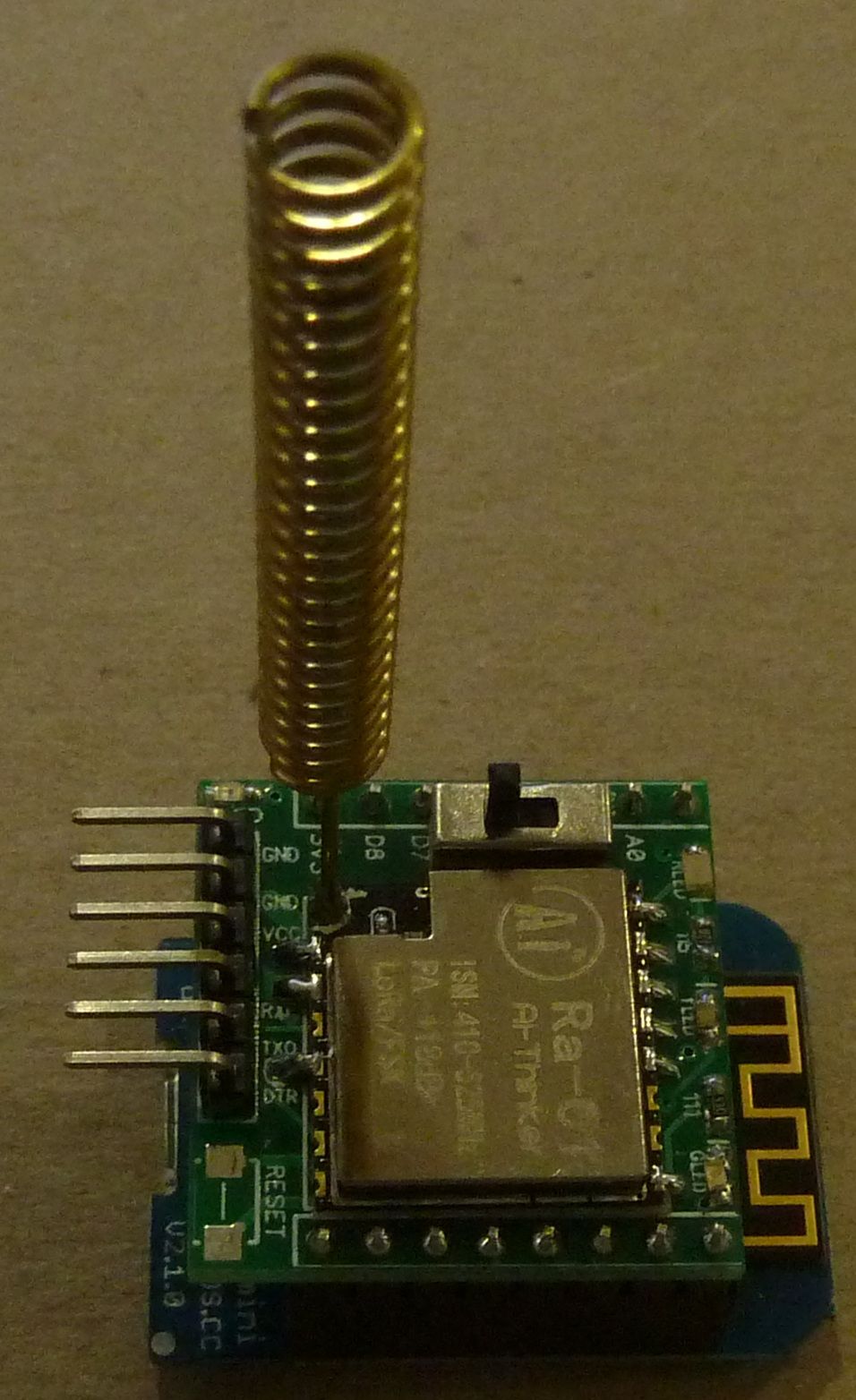
The shield on top can be demounted and is a fully-standalone atmega328p driving the LoRa radio, which makes for a complete solution that's not much larger than the AI-Thinker module itself! I'll just drop a 915Mhz Ai-Thinker LoRa module into place instead of the 433Mhz module currently there, and, bang, it should "just work."
I suppose desoldering the IPEX connector on the EBYTE module I could perhaps make a short jumper run from a custom PCB onto the EBYTE antenna pad..... Hmmm.... Kludgy, but it might work. In contrast, however, with the AI-Thinker modules there's a through-hole already set aside for a whip antenna.
-
Which thickness of coax cable should one prefer? Is thicker generally better? For instance, here are two connector cables of the same type, and both 50 ohm, but one is 0.81mm coax, and the other is 1.13mm coax. Does the difference matter?
https://www.amazon.com/gp/product/B098QGFZ2J/ref=crt_ewc_title_dp_3?ie=UTF8&psc=1&smid=AODZVW3FCSGNT
https://www.amazon.com/gp/product/B098QF5XF8/ref=crt_ewc_title_dp_1?ie=UTF8&psc=1&smid=AODZVW3FCSGNT
[Edit: I do notice that they have different IPEX connectors, but I'm wondering just about the coax diameter.]
@NeverDie The characteristic impedance of the coax is what matters. And that is all determined by the construction, which includes the thickness, but also other things, like what dielectric, and probably even what metal is used. (I don't know all the variables that they have to play with.)
So it could be that both of those options you posted are fine. But buying stuff like this on Amazon, especially through third parties is a crap shoot. No telling if it will be good or not, and the reviews aren't usually very helpful, either, on RF stuff. Not saying you shouldn't do it - I will gamble myself, but just go in fully aware that your chances of getting something shoddy are good, and make sure the price you pay is worth the gamble.
-
@NeverDie The characteristic impedance of the coax is what matters. And that is all determined by the construction, which includes the thickness, but also other things, like what dielectric, and probably even what metal is used. (I don't know all the variables that they have to play with.)
So it could be that both of those options you posted are fine. But buying stuff like this on Amazon, especially through third parties is a crap shoot. No telling if it will be good or not, and the reviews aren't usually very helpful, either, on RF stuff. Not saying you shouldn't do it - I will gamble myself, but just go in fully aware that your chances of getting something shoddy are good, and make sure the price you pay is worth the gamble.
@ejlane Agreed. Where is it that you prefer to shop?
A lot of the amazon stuff is the same as what one might find on Aliexpress, but the difference is I can get it fast and with free shipping from Amazon, and returns are a breeze. When it comes to quality, I think Mouser or Digikey usually has the best, but at usually higher prices even before you figure in shipping. Is there anywhere else worth considering? Maybe there's a good resource I've overlooked.
-
@ejlane Agreed. Where is it that you prefer to shop?
A lot of the amazon stuff is the same as what one might find on Aliexpress, but the difference is I can get it fast and with free shipping from Amazon, and returns are a breeze. When it comes to quality, I think Mouser or Digikey usually has the best, but at usually higher prices even before you figure in shipping. Is there anywhere else worth considering? Maybe there's a good resource I've overlooked.
@NeverDie I think you've pretty much covered it. Yes, sometimes there's no good hobby-level alternative to Amazon/Aliexpress if you want it cheap.
Though someplace like SparkFun or Adafruit can be good for hobbyists, though you'll pay for it.
Along with Mouser and Digikey, sometimes I have good luck with Arrow or Newark. But really, it's nice to do a search with octopart.com or findchips.com if you have a pretty good idea of what you want. They will look at lots of vendors, even some that might be shading towards gray market. Can really save some time, and sometimes find things that I never would have otherwise. Saved me a few months ago on a customer project that would have otherwise had to be completely redesigned.
